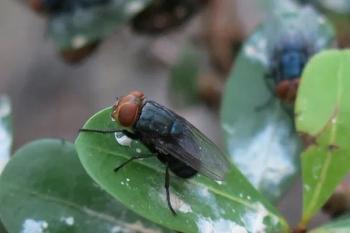
As screwworm nears the border, an expert explains how it spreads and what it means for the US
Most adult screwworms travel less than 10 miles to find a host. The greater risk comes from the movement of cattle, deer, and other hosts, explained Christopher Lee, DVM, MPH, DACVPM, in this Vet Watch update.
How far can the New World screwworm really fly? And does its latest detection in Mexico mean it’s on the verge of entering the US? In this Vet Watch update, Christopher Lee, DVM, MPH, DACVPM, breaks down the parasite’s movement timeline and explains what government agencies are doing in response.
Transcript:
Christopher Lee, DVM, MPH, DACVPM: Welcome back to Vet Watch. I'm Christopher Lee. How fast and how far can the New World screwworm really fly? Cochliomyia hominivorax has been reported to travel as far as 125 miles during its short 1- to 2-week lifespan.
With the September 21, 2025, report of a case in Nuevo León, [Mexico],
The answer is likely no. [Although] their long-distance potential is real, most adult screwworms fly only a few miles—usually less than 10—searching for hosts to lay their eggs in. They are not strategizing about the US-Mexico border; they're simply looking for their next wound or opening in the skin.
Still, the parasites’ progress north has been undeniable, and history tells the story.
- July 3, 2023: Panama declared a state of emergency. Just days later, Costa Rica followed suit.
- By the end of 2024: Every Central American nation had identified cases of screwworm.
- November 22, 2024: Screwworm larvae were discovered in a cow at the Mexico-Guatemala border crossing, approximately 700 miles south of Texas.
- July 9, 2025: A detection [was reported] in Veracruz, approximately 370 miles south of the US border.
- September 21, 2025: [A screwworm case was reported in] Nuevo León, only 70 miles from Texas.
This steady northward march paints a clear picture.
How do they spread?
Most screwworm migration does not come from adult flies making heroic flights northward. Instead, it comes from the movement of infested animals—cattle, deer, wildlife—and yes, even in rare cases, people. Wherever the animal goes, the parasite goes with them.
So, what's being done?
Well, the US government is doing quite a lot1:
- Active deployment of novel traps and lures to detect screwworms early.
- Construction of a
new sterile fly facility at Moore Air Force Base in Edinburg, Texas, capable of producing 300 million sterile flies every week. - Expansion of border surveillance, including USDA [US Department of Agriculture] Tick Riders on horseback patrolling ranch lands and wildlife corridors.
- Close collaboration with [the National Service of Agro-Alimentary Public Health, Safety, and Quality] in Mexico to help contain outbreaks before they reach [the US] border.
- Rigorous inspection of livestock and carcasses by the USDA Food Safety and Inspection Service to safeguard the food supply.
Does this extra effort matter?
I mean, if screwworms seem destined to cross the US border, should we be doing all this? Absolutely. Every day gained [and] every outbreak slowed buys us time—time to strengthen surveillance, to prevent and eradicate, and to save animal and human lives.
Eradication, once this parasite enters, will not happen overnight. Vigilance and preparation will determine how much damage it causes later.
Stay informed, stay vigilant, and remember: What you know today protects everybody tomorrow.
RELATED:
Reference
- USDA announces sweeping plans to protect the United States from New World screwworm. News release. US Department of Agriculture. August 15, 2025. Accessed October 1, 2025.
https://www.usda.gov/about-usda/news/press-releases/2025/08/15/usda-announces-sweeping-plans-protect-united-states-new-world-screwworm
Newsletter
From exam room tips to practice management insights, get trusted veterinary news delivered straight to your inbox—subscribe to dvm360.






